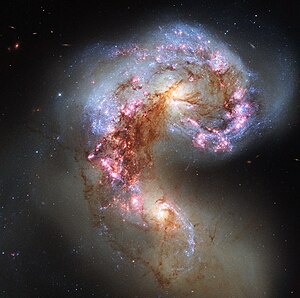Antennen-Galaxien
| Galaxie Antennengalaxien | |
|---|---|
(c) ESA/Hubble, CC BY 4.0 | |
| Die Galaxien NGC 4038 (oben) und NGC 4039 (unten) aufgenommen vom Hubble-Weltraumteleskop. | |
| AladinLite | |
| Sternbild | Rabe |
| Position Äquinoktium: J2000.0, Epoche: J2000.0 | |
| Rektaszension | 12h 01m 53s [1][2] |
| Deklination | −18° 52′ 35″ [1][2] |
| Erscheinungsbild | |
| Morphologischer Typ | SB(s)m pec SA(s)m pecLINERSbrst[2][1] |
| Helligkeit (visuell) | 10,3 mag[3] 10,4 mag[4] |
| Helligkeit (B-Band) | 10,9 mag[3] 11,0 mag[4] |
| Winkelausdehnung | 2,0′ × 1,25′ 1,2′ × 0,75′ |
| Positionswinkel | 94°[3] 55°[4][3] |
| Flächenhelligkeit | 12,1 mag/arcmin²[3] 11,0 mag/arcmin²[4] |
| Physikalische Daten | |
| Zugehörigkeit | LGG 263[1][5] |
| Rotverschiebung | 0,00545 ± 0,000030[1] |
| Radialgeschwindigkeit | (1633 ± 9) km/s[1] |
| Hubbledistanz H0 = 73 km/(s • Mpc) | (66 ± 5) · 106 Lj (20,2 ± 1,4) Mpc [1] |
| Durchmesser | 40.000 + 25.000 Lj[6][7] |
| Geschichte | |
| Entdeckung | William Herschel |
| Entdeckungsdatum | 7. Februar 1785 |
| Katalogbezeichnungen | |
| NGC 4038 / 4039 • UGC A 264 / 265 • PGC 37967 / 37969 • ESO 572-47 / 572-48 • MCG -03-31-014 / -03-31-015 • IRAS 11593-1835 • 2MASX J12015317-1852379 • SGC 115919-1835.2 / 115920-1836.4 • Arp 244 • VV 245 • GC 2670 / 2671 • H IV 28(1) / IV 28(2) • h 1052 / 1053 • | |
| z, v & Entfernung: Mittelwert beider Galaxien | |
Die Antennen-Galaxien bilden ein Paar stark miteinander wechselwirkender Galaxien im Sternbild Rabe südlich des Himmelsäquators. Das Paar besteht aus den beiden etwa 66 Millionen Lichtjahre entfernten Galaxien NGC 4038 und NGC 4039.[8]

Durch die Verschmelzung der beiden Galaxien wird insbesondere das interstellare Gas verdichtet und Sternentstehung induziert. Die dabei gebildeten Sternentstehungsgebiete bzw. die dazugehörenden Emissionsnebel sind als helle Knoten in den Spiralarmen sichtbar. Halton Arp gliederte seinen Katalog ungewöhnlicher Galaxien nach rein morphologischen Kriterien in Gruppen. Diese Galaxie gehört zu der Klasse Galaxien mit Anzeichen für eine Aufspaltung. Die Antennen-Galaxien wurden am 7. Februar 1785 vom deutsch-britischen Astronomen William Herschel entdeckt.[9]
Weblinks
- Antennen-Galaxien in verschiedenen Wellenlängen des Lichts
- Die Antennen – Astronomy Picture of the Day vom 7. Mai 2010.
- Arp Atlas of Peculiar Galaxies
- Seligman Arp
- Antennae Galaxies reloaded (engl.)
- CDS Portal
- CDS Portal
Literatur
- Jeff Kanipe und Dennis Webb: The Arp Atlas of Peculiar Galaxies – A Chronicle and Observer´s Guide, Richmond 2006, ISBN 978-0-943396-76-7
- König, Michael & Binnewies, Stefan (2019): Bildatlas der Galaxien: Die Astrophysik hinter den Astrofotografien, Stuttgart: Kosmos, S. 244
Einzelnachweise
Auf dieser Seite verwendete Medien
This Hubble Space Telescope image provides a detailed look at a brilliant "fireworks show" at the center of a collision between two galaxies. Hubble has uncovered over 1,000 bright, young star clusters bursting to life as a result of the head-on wreck.
[Left] A ground-based telescopic view of the Antennae galaxies (known formally as NGC 4038/4039) - so named because a pair of long tails of luminous matter, formed by the gravitational tidal forces of their encounter, resembles an insect's antennae. The galaxies are located 63 million light-years away in the southern constellation Corvus.
[Right] The respective cores of the twin galaxies are the orange blobs, left and right of image center, crisscrossed by filaments of dark dust. A wide band of chaotic dust, called the overlap region, stretches between the cores of the two galaxies. The sweeping spiral- like patterns, traced by bright blue star clusters, shows the result of a firestorm of star birth activity which was triggered by the collision.
This natural-color image is a composite of four separately filtered images taken with the Wide Field Planetary Camera 2 (WFPC2), on January 20, 1996. Resolution is 15 light-years per pixel (picture element).
Credit: Brad Whitmore (STScI) and NASAAutor/Urheber: Roberto Mura, Lizenz: CC BY-SA 3.0
Caldwell Catalogue objects.
(c) ESA/Hubble, CC BY 4.0
The NASA/ESA Hubble Space Telescope has snapped the best ever image of the Antennae Galaxies. Hubble has released images of these stunning galaxies twice before, once using observations from its Wide Field and Planetary Camera 2 (WFPC2) in 1997, and again in 2006 from the Advanced Camera for Surveys (ACS). Each of Hubble’s images of the Antennae Galaxies has been better than the last, due to upgrades made during the famous servicing missions, the last of which took place in 2009.
The galaxies — also known as NGC 4038 and NGC 4039 — are locked in a deadly embrace. Once normal, sedate spiral galaxies like the Milky Way, the pair have spent the past few hundred million years sparring with one another. This clash is so violent that stars have been ripped from their host galaxies to form a streaming arc between the two. In wide-field images of the pair the reason for their name becomes clear — far-flung stars and streamers of gas stretch out into space, creating long tidal tails reminiscent of antennae.
This new image of the Antennae Galaxies shows obvious signs of chaos. Clouds of gas are seen in bright pink and red, surrounding the bright flashes of blue star-forming regions — some of which are partially obscured by dark patches of dust. The rate of star formation is so high that the Antennae Galaxies are said to be in a state of starburst, a period in which all of the gas within the galaxies is being used to form stars. This cannot last forever and neither can the separate galaxies; eventually the nuclei will coalesce, and the galaxies will begin their retirement together as one large elliptical galaxy.
This image uses visible and near-infrared observations from Hubble’s Wide Field Camera 3 (WFC3), along with some of the previously-released observations from Hubble’s Advanced Camera for Surveys (ACS).



